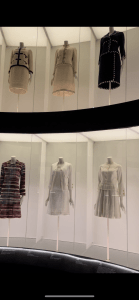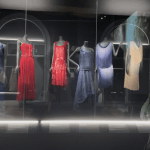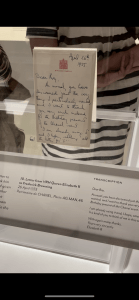This past September I attended the new Chanel Manifesto exhibition located in the V&A museum in London, and it was a remarkable experience. Upon arrival, you are allocated into a group so that the rooms don’t get overly crowded and cramped, but you are free to explore beyond that group and witness everything at your own pace. This limitation of numbers was absolutely necessary, as there is a lot of information to read and fashion pieces to absorb, and it allowed for a more relaxed and slow-paced experience.
Once my group had gained access to the exhibition, there was immediately a timeline to present the evolution of the Chanel legacy, and this evolution was then demonstrated through her fashion pieces as you progressed throughout the museum. Importantly, the timeline did not stray from discussing the fact that Gabrielle Chanel dated the Nazi officer Barons Hans Gϋnther von Dincklage in order to get her nephew, André Palasse, out of prison. It crucially mentioned that in 1941, Chanel was appointed as a German spy under the code-name Agent F-7124, and her nephew was released from German imprisonment. This complicated history continues to divide people as to whether they can support the Chanel brand today, on this matter I will say that currently Chanel is owned by Alain and Gerard Wertheime – a Jewish family, so any current support does not benefit anyone affiliated to Nazis in the past. 
But returning now to the exhibition, the V&A did a profound job at making it immersive by using a combination of presentation techniques, including: mannequins modelling her original designs, written notes, her portfolio of rough sketches of fashion items before they came into fruition, the original compacts for her makeup and skincare products, motion-picture videos demonstrating models cat-walking the runway to showcase Chanel’s designs, posters with the original advertisements for her fashion, and a showcase dedicated to the original quilted Chanel bag – arguably the most recognisable fashion item in the world. This range of presentations for the evolution of the Chanel brand allowed the exhibition to transport you to era of Gabrielle Chanel, and highlight how original and refreshing this brand was for women at the time.
One thing that surprised me about Chanel’s fashion story is how Gabrielle was able to simultaneously create unique and timeless items. Nowadays, the Chanel brand seems to regurgitate the same quilted bag design and tweed jackets; yet Gabrielle Chanel was constantly pushing the boundaries in every collection – unafraid to shorten hemlines, layer items, and use expensive materials whilst in the middle of a war. For Gabrielle, women were at the heart of everything she designed – she managed to design decade-defying pieces by designing confidence and elegance.
When I think about Chanel, I imagine monochromatic pieces, such as black, due to her iconic creation of the Little Black Dress, or cream, as the tweed suits come in multiple variations of cream, white, off-white, eggshell, and so on. But my conception of the brand was surprisingly proved incorrect when I examined her fashion collection as a whole at the exhibition. There was an entire section dedicated to the Roaring Twenties, flapper-style dresses that came in vibrant reds, blues and purples – ranging in hemline length with variations of sequin styles (see photo on the right-hand side).
The exhibition portrayed more than just her fashion. There were rooms dedicated to her makeup, skincare, and perfume collection – all showcased in their original, cardboard, white packaging. A standout item was a letter written by HRH Queen Elizabeth II to Frederick Browning on 26th April, 2955, thanking him for sending her a bottle of the Chanel No.5 perfume, that she is already wearing every day (see photo to the left). The entire collection finished with a show-stopping floor-to-ceiling stairwell demonstrating the most exquisite ballgown dresses I have ever witnessed (see featured image).
This exhibition is limited edition, beginning in September 2023 (which is when I attended) and concluding in February 2024. Tickets can be found on the V&A museum website, and is free to attend for members. It is an experience unlike any other, and I left with a new sense of admiration and respect for Gabrielle Chanel’s innovative vision and design-process. Her ability to deliver function, elegance, and confidence is what has kept her fashion timeless and continuously sought after.
All images within article photographed by: Kirsten Meek
Featured image: from Kirsten Meek


